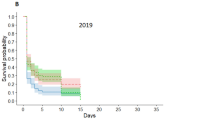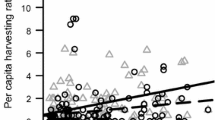Abstract
Seed traits play an important role in seed dispersal and possibly in eventual plant community structure and dynamics. Though seed traits have been shown to influence seed dispersal of one given tree species, it is not clear if and how seed dispersal and seed survival of one tree species are affected by neighboring tree species at inter-specific level. In the present study, we investigated acorn dispersal of two oak species Q. variabilis (bearing large acorn) and Q. serrata var. brevipetiolata (bearing small acorn) in the presence of sympatric Q. aliena acorns (medium size), to test the ‘context-dependent’ hypothesis, which states that seed dispersal patterns of one tree species can be affected by sympatric tree species at inter-specific level. Our results showed that the probability of acorn removal of Q. variabilis was higher in the presence of Q. aliena acorns. However, the presence of Q. aliena acorns significantly decreased acorn removal rates of Q. serrata var. brevipetiolata. Acorns of Q. serrata var. brevipetiolata were less likely to be cached by small rodents in the presence of Q. aliena acorns, whereas, acorns of Q. variabilis tended to be scatter-hoarded in the presence of Q. aliena acorns. The presence of Q. aliena acorns promoted Q. variabilis acorns to establish seedlings, but arrested seed-seedling transition in Q. serrata var. brevipetiolata. Our study verifies the interspecific interactions of seed dispersal systems of sympatric oak species, showing the ‘context-dependent’ hypothesis that seed dispersal of one given tree species can be regulated by another or more sympatric tree species bearing seeds with contrasting traits.



Similar content being viewed by others
References
Brewer SW (2001) Predation and dispersal of large and small seeds of a tropical palm. Oikos 92:245–255
Briones-Salas M, Sanchez-Cordero V, Sanchez-Rojas G (2006) Multi-species fruit and seed removal in a tropical deciduous forest in Mexico. Can J Bot 84:433–442
Caccia FD, Chaneton EJ, Kitzberger T (2006) Trophic and non-trophic pathways mediate apparent competition through post-dispersal seed predation in a Patagonian mixed forest. Oikos 113:469–480
Carlo TA (2005) Interspecific neighbors change seed dispersal pattern of an avian-dispersed plant. Ecology 86:2440–2449
Chang G, Xiao Z, Zhang Z (2009) Hoarding decisions by Edward’s long-tailed rats (Leopoldamys edwardsi) and South China field mice (Apodemus draco): the responses to seed size and germination schedule in acorns. Behav Proc 82:7–11
Chang G, Jin T, Pei J, Chen X, Zhang B, Shi Z (2012) Seed dispersal of three sympatric oak species by forest rodents in the Qinling Mountains, Central China. Plant Ecol 213:1633–1642
Chauvet S, Feer F, Forget PM (2004) Seed fates of two Sapotaceae species in a Guianan rain forest in the context of escape and satiation hypotheses. J Trop Ecol 20:1–9
Chen X, Cannon CH, Conklin-Brittan NL (2012) Evidence for a trade-off strategy in stone oak (Lithocarpus) seeds between physical and chemical defense highlights fiber as an important antifeedant. PLoS One 7(3):e32890
Gómez JM (2003) Spatial patterns in long-distance of Quercus ilex acorns by jays in a heterogeneus landscape. Ecography 26:573–584
Gómez JM (2004) Bigger is not always better: conflicting selective pressures on seed size in Quercus ilex. Evolution 58:71–80
Gómez JM, Puerta-Piñero C, Schupp EW (2008) Effectiveness of rodents as local seed dispersers of Holm oaks. Oecologia 155:529–537
Heredia A, Detrain C (2005) Influence of seed size and seed nature on recruitment in the polymorphic harvester ant Messor barbarus. Behav Proc 70:289–300
Hoshizaki K, Hulme PE (2002) Mast seeding and predatormediated indirect interactions in a forest community: evidence from post-dispersal fate of rodent-generated caches. In: Levey D, Silva WR, Galetti M (eds) Seed dispersal, frugivory: ecology, evolution, conservation. CABI Publishing, Wallingford, pp 227–239
Hulme PE, Hunt MK (1999) Rodent post-dispersal seed predation in deciduous woodland: predator response to absolute and relative abundance of prey. J Anim Ecol 68:417–428
Jansen PA, Bartholomeus M, Bongers F, Elzinga JA, Den Ouden J, Van Wieren SE (2002) The role of seed size in dispersal by a scatter-hoarding rodent. In: Levey D, Silva WR, Galetti M (eds) Seed dispersal, frugivory: ecology, evolution, conservation. CABI Publishing, Wallingford, pp 209–225
Jansen PA, Bongers F, Hemerik L (2004) Seed mass and mast seeding enhance dispersal by a noetropical scatter-hoarding rodent. Ecol Monogr 74:569–589
Kelly D (1994) The evolutionary ecology of mast seeding. Trends Ecol Evol 9:465–470
Kelly D, Sork VL (2002) Mast seeding in perennial plants: why, how, where? Ann Rev Ecol Syst 33:427–447
Kennedy PG (2005) Post-dispersal seed predation varies by habitat not acorn size for Quercus chrysolepis (Fagaceae) and Lithocarpus densiflora (Fagaceae) in central coastal California. Madronõ 52:30–34
Klinger R, Rejmánek M (2009) The numerical and functional responses of a granivorous rodent and the fate of Neotropical tree seeds. Ecology 90:1549–1563
Lai X, Xiao Z, Guo C (2014) Trait-mediated seed predation, dispersal and survival among frugivore-dispersed plants in a fragmented subtropical forest, Southwest China. Integr Zool 9:246–254
Lei J, Shen Z, Yi X (2012) Pericarp thickness and seed size determine acorn dispersal of five rodent-dispersed oak species. Acta Theriol Sin 32:83–89
Li H, Zhang Z (2007) Effects of mast seeding and rodent abundance on seed predation and dispersal by rodents in Prunus armeniaca (Rosaceae). Forest Ecol Manag 242:511–517
Lichti NI, Steele MA, Zhang H, Swihart RK (2014) Mast species composition alters seed fate in North American rodent-dispersed hardwoods. Ecology 95:1746–1758
Meng L, Gao X, Chen J, Martin K (2012) Spatial and temporal effects on seed dispersal and seed predation of Musa acuminata in southern Yunnan, China. Integr Zool 7:30–40
Moles AT, Warton D, Westoby M (2003) Do small-seeded species have higher survival through seed predation than large-seeded species? Ecology 84:3148–3161
Moore J, McEuen AB, Swihart RK, Contreras TA, Steele MA (2007) Determinants of seed removal distance by scatter-hoarding rodents in deciduous forests. Ecology 88:2529–2540
Morales JM, Rivarola MD, Amico G, Carlo TA (2012) Neighborhood effects on seed dispersal by frugivores: testing theory with a mistletoe–marsupial system in Patagonia. Ecology 93:741–748
Muňoz A, Bonal R (2008) Are you strong enough to carry that seed? Seed size/body size ratios influence seed choices by rodents. Anim Behav 76:709–715
Matsuda I, Higashi S, Otani Y, Tuuga A, Bernard H, Corlett RT (2013) A short note on seed dispersal by colobines: the case of the proboscis monkey. Integr Zool 8:395–399
O’Farrill G, Galetti M, Campos-Arceiz A (2013) Frugivory and seed dispersal by tapirs: an insight on their ecological role. Integr Zool 8:4–17
Perea R, Miguel AS, Martinez-Jauregui M, Valbuena-Carabana M, Gil L (2012a) Effects of seed quality and seed location on the removal of acorns and beechnuts. Europ J Forest Res 131:623–631
Perea R, Miguel AS, Lopez D (2012b) Incorporating insect infestation into rodent seed dispersal: better if the larva is still inside. Oecologia 170:723–733
Pons J, Pausas JG (2007a) Rodent acorns selection in a Mediterranean oak landscape. Ecol Res 22:535–541
Pons J, Pausas JG (2007b) Not only size matters: acorn selection by the European jay (Garrulus glandarius). Acta Oecol 31:353–360
Schupp EW, Fuentes M (1995) Spatial patterns of seed dispersal and the unification of plant population ecology. Ecoscience 2:267–275
Shimada T (2001) Hoarding behaviors of two wood mouse species: different preference for acorns of two Fagaceae species. Ecol Res 16:127–133
Smallwood PD, Peters WD (1986) Grey squirrel food preferences: the effect of tannin and fat concentration. Ecology 67:168–174
Smallwood PD, Steele MA, Faeth SH (2001) The ultimate basis of the caching and dispersers. In: Murray DR (ed) Seed dispersal. Academic Press, Sydney, pp 191–235
Steele MA, Hadj-Chikh LZ, Hazeltine J (1996) Caching and feeding decisions by Sciurus carolinensis: responses to weevil-infested acorns. J Mammal 77:305–314
Terborgh J, Nuñez-Ituri G, Pitman N, Cornejo F, Alvarez P, Pringle B, Swamy V, Paine T (2008) Tree recruitment in an ‘empty’ forest. Ecology 89:1757–1768
Theimer TC (2003) Intra-specific variation in seed size affects scatterhoarding behaviour of an Australian tropical rain forest rodent. J Trop Ecol 17:177–189
Vander Wall SB (1990) Food hoarding in animals. University of Chicago Press, Chicago
Vander Wall SB (2001) The evolutionary ecology of nut dispersal. Bot Rev 67:74–117
Vander Wall SB (2002) Masting in animal-dispersed pines facilitates seed dispersal. Ecology 83:3508–3516
Vander Wall SB (2003) Effects of seed size of wind-dispersed pines (Pinus) on secondary seed dispersal and the caching behavior of rodents. Oikos 100:25–34
Vander Wall SB, Longland WS (2004) Diplochory: are two seed dispersers better than one? Trends Ecol Evol 19:155–161
Wang B, Chen J (2008) Tannin concentration enhances seed caching by scatterhoarding rodents: an experiment using artificial ‘seeds’. Acta Oecol 34:379–385
Wang B, Chen J (2009) Seed size, more than nutrient or tannin content, affects seed caching behavior of a common genus of Old World rodents. Ecology 90:3023–3032
Wang B, Chen J (2011) Scatter-hoarding rodents prefer slightly astringent food. PLoS One 6:e26424
Wang B, Wang G, Chen J (2012) Scatter-hoarding rodents use different foraging strategies for seeds from different plant species. Plant Ecol 213:1329–1336
Wang Z, Cao L, Zhang Z (2014) Seed traits and taxonomic relationships determine the occurrence of mutualisms versus seed predation in a tropical forest rodent and seed dispersal system. Integr Zool 9:309–319
Xiao Z, Zhang Z, Wang Y (2004) Dispersal and germination of big and small nuts of Quercus serrata in subtropical evergreen broadleaved forest. Forest Ecol Manag 195:141–150
Xiao Z, Wang Y, Harris M, Zhang Z (2006) Spatial and temporal variation of seed predation and removal of sympatric large-seeded species in relation to innate seed traits in a subtropical forest, Southwest China. Forest Ecol Manage 222:46–54
Xiao Z, Chang G, Zhang Z (2008) Testing the high-tannin hypothesis with scatter-hoarding rodents: experimental and field evidence. Anim Behav 75:1235–1241
Xiao Z, Gao X, Jiang M, Zhang Z (2009) Behavioral adaptation of Pallas’s squirrels to germination schedule and tannins in acorns. Behav Ecol 20:1050–1055
Xiao Z, Gao X, Steele M, Zhang Z (2010) Frequency-dependent selection by tree squirrels: adaptive escape of nondormant white oaks. Behav Ecol 21:169–175
Xiao Z, Gao X, Zhang Z (2013a) Sensitivity to seed germination schedule by scatter-hoarding Pére David’s rock squirrels during mast and non-mast years. Ethology 119:472–479
Xiao Z, Gao X, Zhang Z (2013b) The combined effects of seed perishability and seed size on hoarding decisions by Pére David’s Rock squirrels. Behav Ecol Sociobiol 67:1067–1075
Xiao Z, Zhang Z, Krebs CJ (2013c) Long-term seed survival and dispersal dynamics in a rodent-dispersed tree: testing the predator satiation hypothesis and the predator dispersal hypothesis. J Ecol 101:1256–1264
Yi X, Yang Y, Zhang Z (2011) Intra- and inter-specific effects of mast seeding on seed fates of two sympatric Corylus species. Plant Ecol 212:785–793
Yi X, Wang Z, Liu C, Liu G (2014) Seed trait and rodent species determine seed dispersal and predation: evidences from semi-natural enclosures. iForest. doi: 10.3832/ifor1185-007
Zhang H, Zhang Z (2008) Endocarp thickness affects seed removal speed by small rodents in a warm-temperate broad-leafed deciduous forest, China. Acta Oecol 158:57–63
Zhang H, Chen Y, Zhang Z (2008) Differences of dispersal fitness of large and small acorns of Liaodong oak (Quercus liaotungensis) before and after seed caching by small rodents in a warm temperate forest, China. Forest Ecol Manag 255:1243–1250
Acknowledgments
This study was financially supported by the National Natural Science Foundation (No. 31470113, 31172101) and the Program for New Century Excellent Talents in University (NCET-12-0693). The authors declare no conflict of this work.
Author information
Authors and Affiliations
Corresponding author
Additional information
Communicated by P. M. Ramsay.
Rights and permissions
About this article
Cite this article
Yi, X., Wang, Z. Context-dependent seed dispersal determines acorn survival of sympatric oak species. Plant Ecol 216, 123–132 (2015). https://doi.org/10.1007/s11258-014-0421-0
Received:
Accepted:
Published:
Issue Date:
DOI: https://doi.org/10.1007/s11258-014-0421-0




